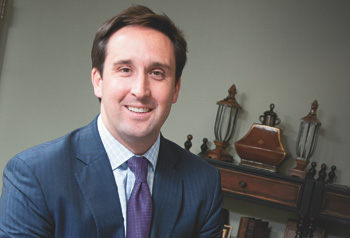Benefits Agency
A strategic perspective
Evolving with the industry is a proven recipe for success for this Georgia agency's benefits division
By Len Strazewski
The Patient Protection and Affordable Care Act will bring a tidal wave of change next year—transforming the employee benefits industry for agents and brokers everywhere. But experienced producers know that the benefits business has never been static—and change has been the only constant.
Bob Shulman, vice chairman and employee benefits producer of Pritchard & Jerden in Atlanta, Georgia, has been marketing employee benefits programs and advising commercial clients for the agency since 1974 and he has seen plenty of evolution in his 39-year career.
The new law is just the next in a long line of changes—but he admits that it is a big one for the industry and his agency.
"The new law may be the biggest source of change in our time, but the business has been undergoing changes steadily for many years—new plan designs, new technology, and a new business environment. We have all had to learn new things."
P&J was founded in in 1960 as a commercial property/casualty insurance agency, specializing in building long-term relationships with local businesses. The agency hired its first benefits producer in 1971 and its second, Shulman, in 1974.
"The agency began like many others of its time, as a property/casualty insurance sales agency," he explains. "But the founders recognized a growing need among their clients for group benefits services and individual coverage such as life and accident insurance," he recalls.
The agency's first benefits producers marketed group health, ancillary benefits including dental insurance and group life, and individual products for business owners. "It was primarily a sales job," Shulman says, "but that was the nature of the employee benefits industry at the time.
"There were a lot of group health insurance carriers active in the marketplace and very little regulation. As benefits producers and advisers, we had many ways to help our clients achieve their goals with both fully-insured and self-funded benefits programs. And the carriers offered quality and quantity."
But the business quickly evolved, he says. With the evolution of new plan designs, including Health Maintenance Organizations (HMOs) and Preferred Provider Organizations (PPOs), the benefits agent's job shifted from sales and marketing to education and consulting as producers explored the new options with their clients.
Nonstop cost increases and changes in health plan competition over more than 20 years drove much of the industry change. "The steady uptick in medical costs led to increases in benefit costs" as new medical techniques and technology enabled individuals to live longer, but more expensively.
The health plan marketplace also contracted, leaving agents and brokers with fewer insurance choices and a much narrower range of rate options. The old technique of bidding out coverage became unproductive as quotes began to relate more to plan design and claims history than to market competition.
However, the Atlanta region stillis a relatively strong marketplace,led by BlueCross/BlueShield of Georgia (with about 40% of the market), Aetna, United Healthcare, Coventry, Humana, Cigna andKaiser Permanente.
Shulman also notes a change in his clients. Cutbacks in human resource departments left companies more reliant on their agents and brokers than ever before. They were needed to help analyze the increasing volume of claims data that helps set benefit costs and to manage the functions associated with benefits administration, communication, enrollment, and regulatory compliance.
As a result, employers have become more focused on "buying the jockey rather than the horse," he says. "Agents and brokers now serve more as business consultants and partners to their clients, assisting employers in developing strategic plans and then helping them execute those plans effectively."
The agency now has 75 employees, including 25 in its employee benefits operation which generates about one-third of total revenue. Six producers (five of whom are agency principals) are supported by account managers and other staff who manage and analyze claims, manage and evaluate technology, and support compliance and human resources services.
Employee benefits producers sell across disciplines, working with property/casualty insurance and risk management specialists to provide a full range of services to clients and round out agency accounts, Shulman says. Cross-selling is highly successful, with a majority of clients using the agency for both property/casualty and employee benefits services.
Clients range in size from 50 to 3,000 employees, but executives say the agency specializes in mid-sized firms with 50 to 1,000 employees.
Shulman describes the department as providing "a service wheel" that includes benefits education, compliance analysis, communication and enrollment, and human resource services as well as traditional insurance brokering. The agency continues to expand its resources led by a new generation of producers with unique training and expertise.
For example, Mike Mewbourne, principal and employee benefits producer, focuses on wellness and health care reform consulting—a critical component of contemporary health benefit programs. A Pritchard & Jerden producer for the past five years, Mewbourne has a college degree in exercise science and a background in benefits consulting.
"We all have taken a more consultative role in our client relationships. As our business evolves and becomes more complicated, it's imperative that we step into a business strategist's role using employee benefits as a means to increase profit margins and enhance employee morale," he says. "There are so many solutions available, and it's our job to find what works for our clients."
The solutions are not one size fits all, Mewbourne notes. Agency experts need to analyze not only risk and plan design, but also the factors that surround the risks, such as the demographics of the workforce, employment locations, access to technology, the use of it, and communication preferences. "We take a team approach, where each team member has a role, different skill set and area of expertise to provide a rounded and comprehensive client support structure," he says.
"We have partnerships with creative and forward-thinking vendors and have embraced technology that enhances our delivery and administrative support functions—capabilities which are increasingly important to our clients," Mewbourne says.
He monitors the latest developments in health and wellness and how they will impact the benefits environment. Health-care reform has triggered broad changes in the way the industry will not only manage benefits but provide related health services.
The new law and its exchange methodology for marketing health insurance coverage shift the perspective on health insurance from corporate consumerism to a retail perspective, he says. Individuals will need to take more responsibility, with supportive education and technology provided by their employers.
Transparency is the next big issue in health-care consumerism, Mewbourne says, and individuals have increasing access to health cost information that will allow them to make more economical choices among services and providers. Individuals now have the ability to analyze prices in their area for routine procedures such as colonoscopies, outpatient services, and diagnostic imaging. "Empowering the employee with medical cost transparency will ultimately drive down claims costs and help make health care more sustainable," he says.
New technology such as telemedicine—health care delivered economically over the Internet and phone—will help individuals avoid costly emergency room care for routine and non-acute medical needs.
Rob Peters, principal and benefits producer, a 12-year veteran of the employee benefits industry, also brings a strategic perspective to client engagement.
He says employers are very interested in learning as much as possible about health-care reform. "We are delivering actuarial studies that weigh the monetary impact of health-care reform. This analysis is the foundation for building strategy and identifying the employer's goals and objectives in the benefits program," Peters explains.
Agency clients and prospects are "soaking up information on health-care reform like a sponge," he says, and a recent seminar P&J delivered drew more than 200 participants.
Peters says employers are also researching new private exchange technology—especially exchanges integrating decision support logic, ancillary and worksite benefits, and defined contribution modeling for funding the cost of benefits.
He says about 35% of client employers already provide Health Reimbursement Accounts (HRAs) and the plan design strategy is increasingly popular.
The agency provides a range of customer service technology to its clients, including the Zywave suite of benefit and compliance portals, HR hotline support, patient advocacy/cost transparency, online enrollment, and automated compliance technology.
Peters says the agency is keeping its clients apprised of emergent issues in health-care cost containment—including new opportunities for analysis of pharmacy benefit management trends. While many prescription drug costs have stabilized with the increased availability of generic drugs, new intravenous specialty drugs will be the big ticket items of the future, he says.
Despite all the new issues facing agents and brokers, Shulman notes that some old tactics are new again. Self-funding of group health insurance was common when he first joined the agency, tapping competitive stop-loss insurance markets and administrative services agreements with health plans and third-party administrators.
Then the stop-loss market dried up as claims costs and radical medical procedures increased, driving more employers back to insured programs. But Shulman notes that the stop-loss insurance marketplace has rebounded and has become newly competitive, allowing small and medium-sized employers to self-fund portions of their group health plan risks.
Larger companies also have the option of self-funding using a benefits captive insurance company, a recent twist on a risk management tactic originally developed for property/casualty risks. "It all depends upon the predictability of your risk, but captives are clearly another viable option for the right companies," he says.
The author
Len Strazewski is a Chicago-based writer, editor and educator specializing in marketing, management and technology topics. In addition to contributing to Rough Notes, he has written on insurance for Business Insurance, Risk & Insurance, the Chicago Tribune and Human Resource Executive, among other publications.
Benefits department executives at Pritchard & Jerden in Atlanta include (from left): Mike Mewbourne, Producer, Life and Employee Benefits; Rob Peters, RHU, Producer, Benefits; and Robert M. Shulman, CLU, Vice Chairman.
"The Patient Protection and Affordable Care Act may be the biggest source of change in our time, but the business has been undergoing changes steadily for many years."
—Robert M. Shulman, CLU
"We are delivering actuarial studies that weigh the monetary impact of health care reform."
—Rob Peters, RHU
"It's imperative that we step into a business strategist's role using employee benefits as a means to increase profit margins and enhance employee morale."
—Mike Mewbourne





